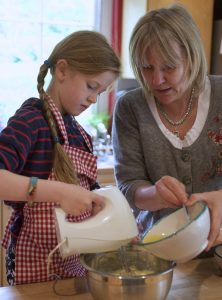How many 10 year olds can cook a meal from scratch? I’m not talking about anything fancy, just a fairly balanced plate of simple, good food. My teaching experience would say, not many, and yet most children are bursting with enthusiasm once you get them into the kitchen. Armed with a few simple techniques and, most importantly, access to “real” food (rather than processed ingredients and miracle ready-to-go mixes) even younger kids can throw something tasty together.

“Real” ingredients are what a good food festival is all about. Grazing your way around stalls laden with great local fare isn’t just about guzzling delicious treats and living in the moment (although that’s undeniably a big part of it), it’s about chatting to producers, discovering new flavours and learning about natural, honest food. The Abergavenny Food Festival is a wonderful place for children to make the vital connection between what they eat and where it comes from, to be adventurous and get excited about food; there will be opportunities to handle farm animals, join interactive sessions on soil and seeds, even mill some flour or do some hands-on cooking.
Meanwhile with weeks of the summer holidays ahead of us there’s plenty of time to get your young’uns helping, or even leading the way, at mealtimes. It’s a win-win-win situation, they’ll have fun whilst learning some vital life skills and you may eventually even get to put your feet up (just be sure to get the clear-up-as-you-go ethic firmly instilled from the outset).
Here are a few tips to get your kids in the kitchen:
- Start ’em young Parents spend a fortune on special sensory baby toys whilst their kitchens are filled with textures and sounds. Just find a secure baby chair, give them a couple of wooden spoons, a saucepan lid and a carrot to gnaw on, then sit them next to you whilst you cook.
- Forget the cutesy chef hats and setting an entire afternoon aside for a themed cup-cakeathon, just try to involve children in day to day jobs – make them your “sous chef”. Get them mashing veg, rolling meat balls or sprinkling the breadcrumbs; children who help around the kitchen just learn to cook by osmosis. Cracking an egg into a bowl for an omelette could be a new experience, or take it up a notch by learning to separate yolks from whites. The next step would be simply seasoning the mix and frying an omelette, one of the most satisfying meals around if you’re using good eggs.
- Teach them some good knife skills as soon as they are coordinated and able. You’ll find plenty of “bridge and claw” guidance on line.
- Repeat a few simple recipes and techniques a number of times There’s nothing better than a kid feeling confident enough to pull something together themselves. We call these head recipes in our house, where my daughter loves to make a chowder, a bean salad with tomatoes and herbs (her call) or a crumble of whatever’s in season.
- Let them take the reins from time to time. It’s a good idea to outline a recipe or an idea and then allow them to look around the shop or market and decide what they might like to cook. This could be as simple as which fruits to use for a fruit salad, which veg for a stir-fry or which fish to cook “en papillote” (making the paper bag to cook the fish in is half of the fun).
- Set them the challenge of a simple meal as soon as they are capable; there’s nothing like the pride of a child who’s put good food on the table.
Jenny Chandler, author of Cool Kids Cook (Pavilion 2016) will be running a workshop on Sunday 17th September as part of the weekend programme of free children’s cooking sessions at The Castle.


